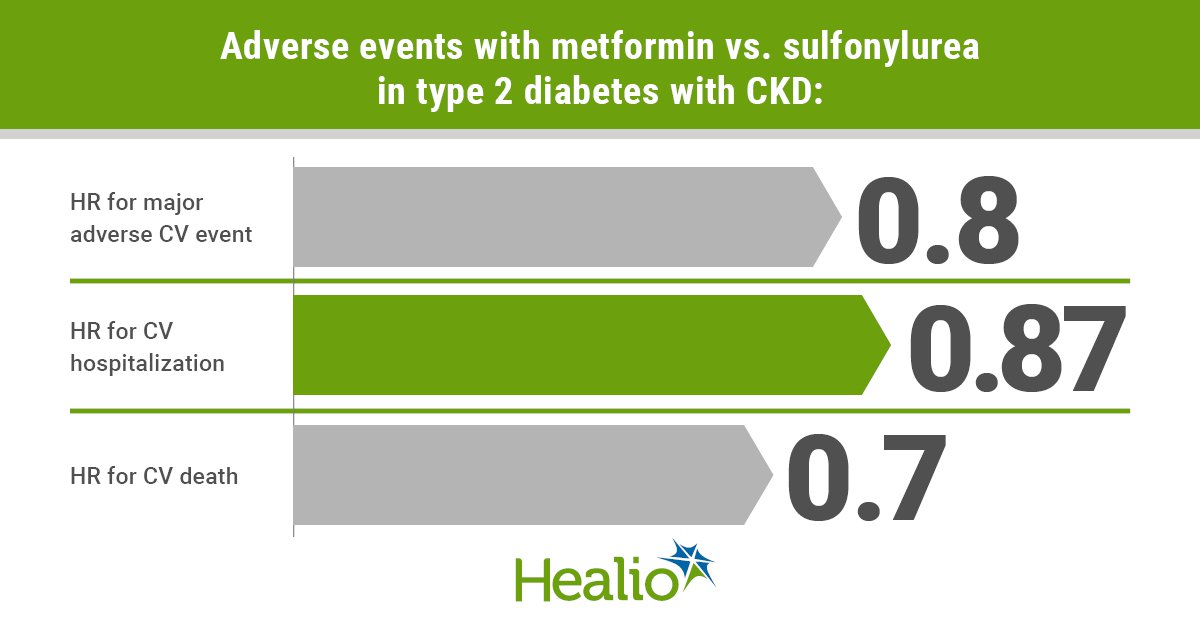CV risk lower with metformin vs. sulfonylurea in diabetes with reduced kidney function
A cohort of veterans with type 2 diabetes and reduced kidney function prescribed metformin monotherapy were less likely to experience a major adverse cardiovascular event during 4 years of follow-up when compared with similar adults prescribed sulfonylurea therapy, according to findings published in JAMA.

“The current study provides important information for the practicing clinician,” Christianne L. Roumie, MD, MPH, associate professor of internal medicine and pediatrics at the Institute for Medicine and Public Health at Vanderbilt University in Nashville, Tennessee, told Endocrine Today. “Among patients with diabetes and reduced kidney function, treatment with metformin compared with a sulfonylurea was associated with a lower risk of major adverse CV events. Metformin should be continued after reaching reduced kidney function.”
In a retrospective study, Roumie and colleagues analyzed data from U.S. veterans with type 2 diabetes who were new users of metformin (n = 67,749) or sulfonylurea monotherapy (n = 28,976), who continued treatment with their glucose-lowering medication after reaching reduced kidney function, defined as an estimated glomerular filtration rate of less than 60 mL/min/1.73 m2 or a creatinine level of at least 1.4 mg/dL for women or at least 1.5 mg/dL for men. Researchers supplemented Veterans Health Administration records with linked data from Medicare, Medicaid and the National Death Index from 2001 through 2016. Patients were followed from the time they reached the reduced kidney function threshold until experiencing a major adverse CV event, treatment change, loss to follow-up, death or study end (December 2016).
Main outcomes were hospitalization for acute myocardial infarction, stroke, transient ischemic attack or CV death. Researchers used propensity score weighting to compare the cause-specific HRs for major adverse CV events between treatments and to estimate cumulative risks that would account for competing risks of a therapy switch and non-CV death. There were 24,679 metformin users and 24,799 sulfonylurea users in the weighted cohort (median age, 70 years; 98% men; 82% white; median HbA1c, 6.6%; median eGFR, 55.8 mL/min/1.73 m2).

During follow-up (median, 1 year for metformin vs. 1.2 years for sulfonylurea), researchers observed 1,048 major adverse CV events (23 per 1,000 person-years) among metformin users and 1,394 events (29.2 per 1,000 person-years) among sulfonylurea users.
The cause-specific, adjusted HR for a major adverse CV event was 0.8 for metformin (95% CI, 0.75-0.86) vs. sulfonylurea use, for an adjusted rate difference of 5.8 (95% CI, 4.1-7.3) fewer events per 1,000 person-years of metformin use compared with sulfonylurea use. Researchers found the cumulative probability of a major adverse CV event for patients in the metformin group vs. the sulfonylurea group was 1.9% vs. 2.5% at 1 year, rising to 3.4% vs. 4.4% at 3 years and 3.8% vs. 4.9% at 4 years.
In analyses stratified by individual CV outcomes, results were similar, with an adjusted HR of 0.87 for CV hospitalization with metformin vs. sulfonylurea (95% CI, 0.8-0.95) and an adjusted HR of 0.7 for CV death (95% CI, 0.63-0.78).
“Our research group is tasked with studying multiple clinical outcomes among patients with diabetes who develop reduced kidney function, including heart failure and progression to end-stage renal disease,” Roumie said. “More comparative effectiveness research to answer questions about existing health care interventions for patients and clinicians is needed to answer many of these questions about common choices for treatment.” – by Regina Schaffer
For more information:
Christianne L. Roumie, MD, MPH, can be reached at the Institute for Medicine and Public Health, Vanderbilt University, 1310 24th Ave. South, GRECC, Nashville, TN 37212; email: christianne.roumie@vanderbilt.edu.
Disclosures: Roumie reports she has received grants from the Veterans Health Administration, the Patient-Centered Outcomes Research Institute and the Agency for Healthcare Research and Quality. Please see the study for all other authors’ relevant financial disclosures.
